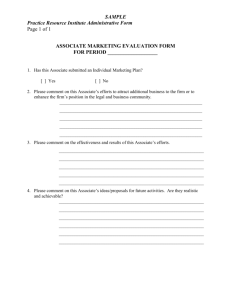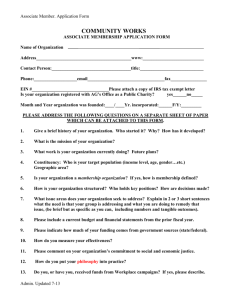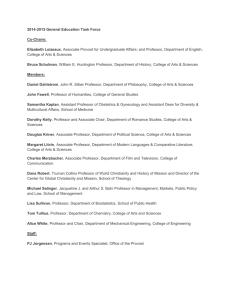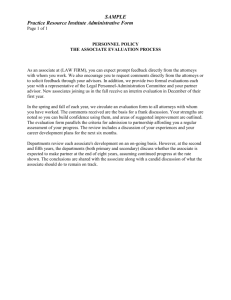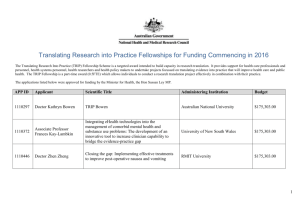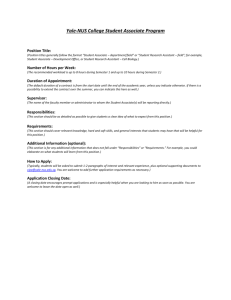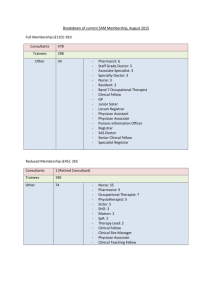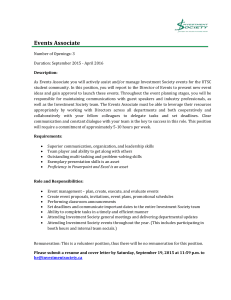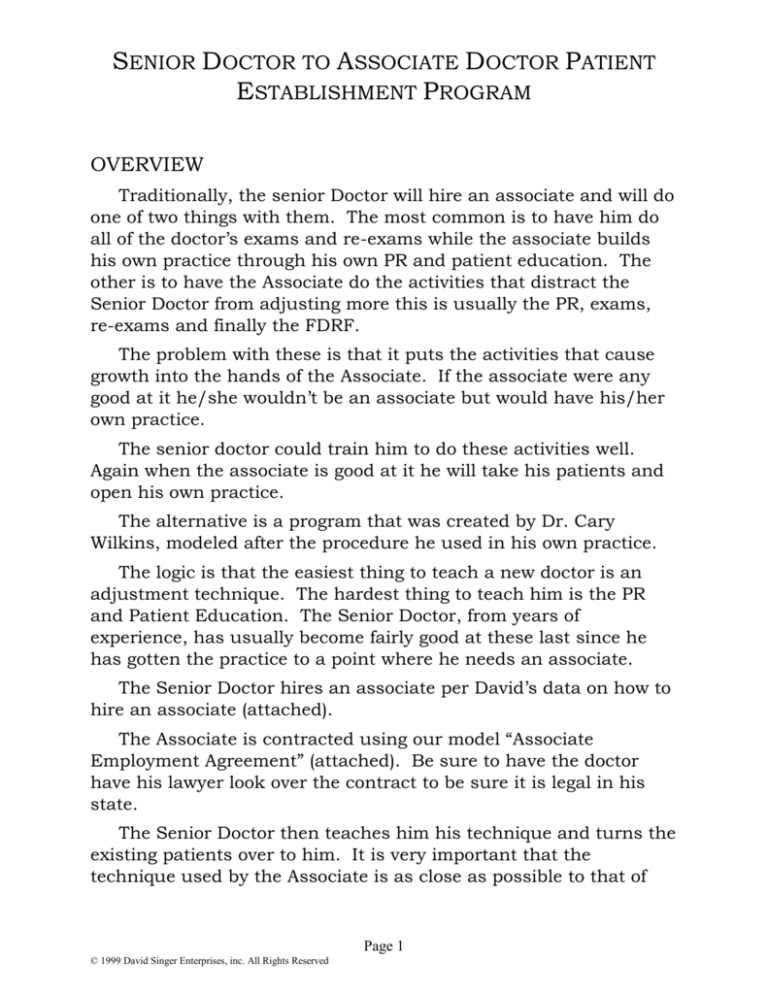
SENIOR DOCTOR TO ASSOCIATE DOCTOR PATIENT
ESTABLISHMENT PROGRAM
OVERVIEW
Traditionally, the senior Doctor will hire an associate and will do
one of two things with them. The most common is to have him do
all of the doctor’s exams and re-exams while the associate builds
his own practice through his own PR and patient education. The
other is to have the Associate do the activities that distract the
Senior Doctor from adjusting more this is usually the PR, exams,
re-exams and finally the FDRF.
The problem with these is that it puts the activities that cause
growth into the hands of the Associate. If the associate were any
good at it he/she wouldn’t be an associate but would have his/her
own practice.
The senior doctor could train him to do these activities well.
Again when the associate is good at it he will take his patients and
open his own practice.
The alternative is a program that was created by Dr. Cary
Wilkins, modeled after the procedure he used in his own practice.
The logic is that the easiest thing to teach a new doctor is an
adjustment technique. The hardest thing to teach him is the PR
and Patient Education. The Senior Doctor, from years of
experience, has usually become fairly good at these last since he
has gotten the practice to a point where he needs an associate.
The Senior Doctor hires an associate per David’s data on how to
hire an associate (attached).
The Associate is contracted using our model “Associate
Employment Agreement” (attached). Be sure to have the doctor
have his lawyer look over the contract to be sure it is legal in his
state.
The Senior Doctor then teaches him his technique and turns the
existing patients over to him. It is very important that the
technique used by the Associate is as close as possible to that of
Page 1
© 1999 David Singer Enterprises, inc. All Rights Reserved
the Senior Doctor. If it isn’t then the existing patients will not
convert over to the Associate. This is accomplished using the
“Senior Doctor To Associate Doctor Patient Turnover Program”
(attached).
This now frees up the Senior Doctor to do PR, FDRF and the reexams. Doing the FDRF and the re-exams establish the Senior
Doctor as the patient’s doctor. The Associate is merely the hands
following the Senior Doctor’s direction. The re-exams now become
more important. They keep the senior doctor in communication
with the patient.
Preferred hours (adjustments only) can now be expanded
broadly as the associate is now available to adjust during the full
hours of the clinic. It is a very good idea to cluster book tightly to
give the associate a break mid shift.
The Senior Doctor can schedule more PR activities to bring in
more NPs to fill up the now expanded adjustment time.
If a patient is having trouble, has questions or is not responding
well he/she is scheduled for a re-exam with the senior doctor.
The particularly interesting problem cases the senior doctor may
want to keep for himself until then are running smoothly. These
generally take more time so it’s good to move them out of the line
up. Plus they are more fun not being routine.
As the associate’s schedule fills up another can be added the
same way.
Should the associate decide to move on they can be easily
replaced in the same manner. An adjuster is much easier to
replace than someone who is trained and responsible for the FDRF
and PR. The patients will rarely follow the associate, as it has been
the Senior Doctor who has been more in comm with him/her. The
Associate can open up across the street and the patients will
generally stay with the Senior Doctor.
Furthermore, the Associate has never learned the two most
important activities to a successful practice: how to get new
patients and how to educate them to stay. Without these abilities
the associate is usually reluctant to leave.
Page 2
© 1999 David Singer Enterprises, inc. All Rights Reserved
ASSOCIATE BONUS
The Associate’s base pay should be based on the cost of living
for the area the clinic is located. The usual is $500, $600 or $700
per week.
Bonusing the Associate is a whole other matter.
Over the years David has had several bonus plans for
associates.
The oldest is based on the amount of visit increase. You take
the highest level of visits that the clinic has made in the last few
months before the associate was hired and that becomes the
baseline. The bonus kicks in at 25 visits above that baseline, an
additional bonus is paid for every 25 visit increase above the
baseline. The bonus to be paid was based on 25 times10% of the
average collected per visit for the last 3 months. [If you did 2500
visits in the last 3 months and collected $100,000 then the average
collection per visit would be $40.00. 10% of that is $4. 25 times
that would be $100. So the associate would get $100 more every
25 visit increase over the baseline established.]
This is a bit complicated. Some doctors got around it by making
it a flat bonus. The baseline is established in the same way and a
flat bonus ($25, $50, $75 or $100) is paid to the associate for each
25 visits above the baseline.
The problem with this is that if the associate doesn’t work out
and only a few of the patient’s, say 40%, are willing to be adjusted
by him then the Senior Doctor carries a majority of the work. The
clinic still rises some but the associate is watching it from his desk
and is being bonused anyway.
In 1996 David came up with a bonus of 20% of the adjustment
fee whenever the associate practices and the main doctor is not
there. This means that the associate would only get bonused for
the slowest days: Saturday, Tuesday and Thursday, but not if the
Senior Doctor decides to come in those days for any reason. The
associate could do 100 visits a day on Monday, Wednesday and
Friday but because the Senior Doctor is present he would get
nothing for it.
Page 3
© 1999 David Singer Enterprises, inc. All Rights Reserved
Cary came up with a rather novel one. The bonus is based on
the visits actually done by the associate.
The baseline is based on the number of visits that the doctor
can reasonably expect to turn over. If he is doing 160 visits then he
can expect the associate to rapidly take over 135 of these. Well I
wouldn’t have the bonus kick in until at least 150. The base pay
covers everything the associate does up to that level. Until the
associate does 150 visits in a week he gets no bonus.
As soon as the 150 is hit the associate gets a bonus for every
visit he has done. If the bonus is $1.00 then the associate gets
$1.00 for each visit he has done, that is a $150 bonus. At 170
visits it is a $170 bonus.
Now we want him to keep stretching for higher numbers. So we
tier the bonus. At each 25 (or 50) visits we raise the bonus $.25 (or
$.50) for each visit. So at 175 the bonus goes up to $1.25 for each
visit. This means that the difference between 174 and 175 visits is
not another buck, but rather an extra $.25 for all 175 visits. At
174 visits it is a $174 bonus, at 175 visits it would be $214.75
bonus (175 x $1.25).
Even if the associate does 325 visits he’s still getting less than
$5.00 total pay and bonus per visit.
I have written up a number of these scales over the years. They
are attached as “Exhibit A’s”.
If the associate gets new patient either by referrals or by
participating in a screening, then he is eligible for the same bonus
as any other staff member. Usually $25 per new patient with the
screening team dividing it up among the whole team.
LOCATING AN ASSOCIATE
There are hundreds of potential associates out there. The
doctor can get a list from his state board of all the DCs who passed
the last two state exams and do a mailing. He can check with the
placement service at the Chiropractic Collages. He can advertise in
the state journal.
Page 4
© 1999 David Singer Enterprises, inc. All Rights Reserved
The ideal associate for this program is the DC who has been out
there and doesn’t want to do anything but adjust.
[Sorry Don, I have to leave. There is more on this.]
Page 5
© 1999 David Singer Enterprises, inc. All Rights Reserved

